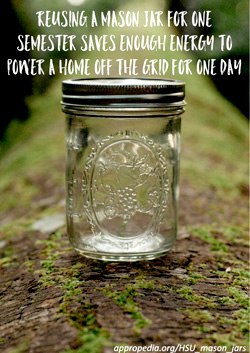
The students built on two facts: HSU prides itself on environmental responsibility, and it sells more than 500 cups of coffee per day. Other students had pushed for a more sustainable way to get that daily caffeine fix. The efforts led to last April’s decision by Dining Services to start selling mason jars at all campus coffee shops.
The idea looked great on paper, but was there a tangible benefit? That’s the question students in instructor Lonny Grafman’s Technology and the Environment (ERE 308) class set out to answer last semester.
Because glass, paper, and plastic all undergo different manufacturing processes, the class set about determining a baseline for comparison. In this case, the energy required to make one cup, reported in kilowatt hours, and the carbon dioxide emissions associated with manufacturing, shipping, and finally the disposal of the cup, reported in kilograms.
Working in six teams, the students determined that a single mason jar requires 1.7 kilowatt-hours of energy for its production and releases 0.469 pounds of carbon dioxide emissions. In comparison, a single paper cup uses 0.261 kilowatt-hours of energy and releases 0.052 kilograms of carbon dioxide.
A single plastic cup—the kind used especially for cold coffee drinks— uses 0.270 kilowatt-hours of energy and releases 0.034 kilograms in emissions.
Students also tried to gauge the likelihood of reusing each cup, noting that almost all plastic and paper cups will end up in the landfill, while nearly 95 percent of mason jars will be reused. So, while much less energy goes into plastic and paper with less carbon dioxide emitted, mason jars have the potential to be much more environmentally friendly. But the trick is encouraging coffee drinkers to reuse them. The students analyzed that, too.
In order to offset the energy and emissions from a mason jar must be reused seven times (energy) and nine times (carbon dioxide), rather than purchase and dispose of a paper cup. As for the plastic cup, a mason jar must be reused six times (energy) and 14 times (carbon dioxide).
Complete results can be viewed online here.
For a look at the fun ways students shared the message of mason-jar energy savings, click here.